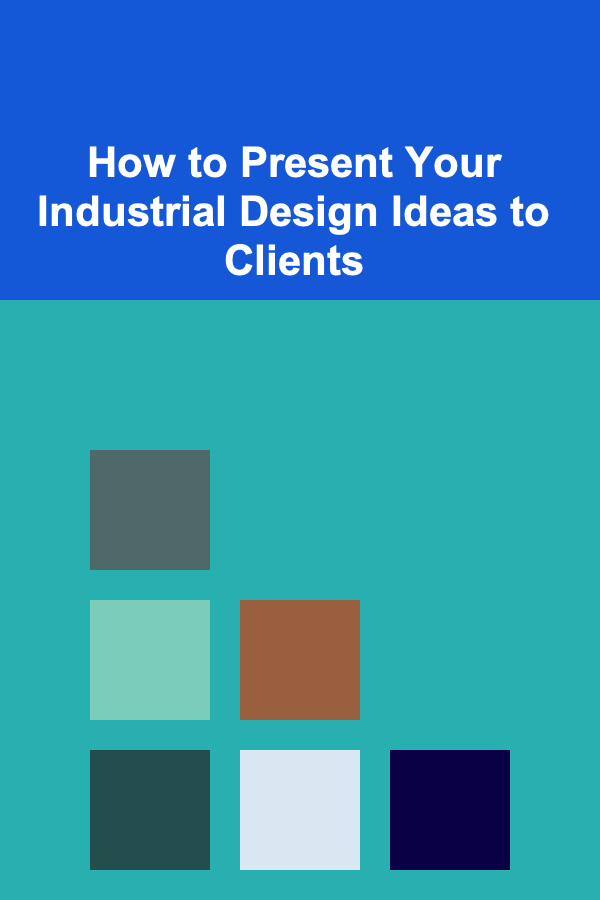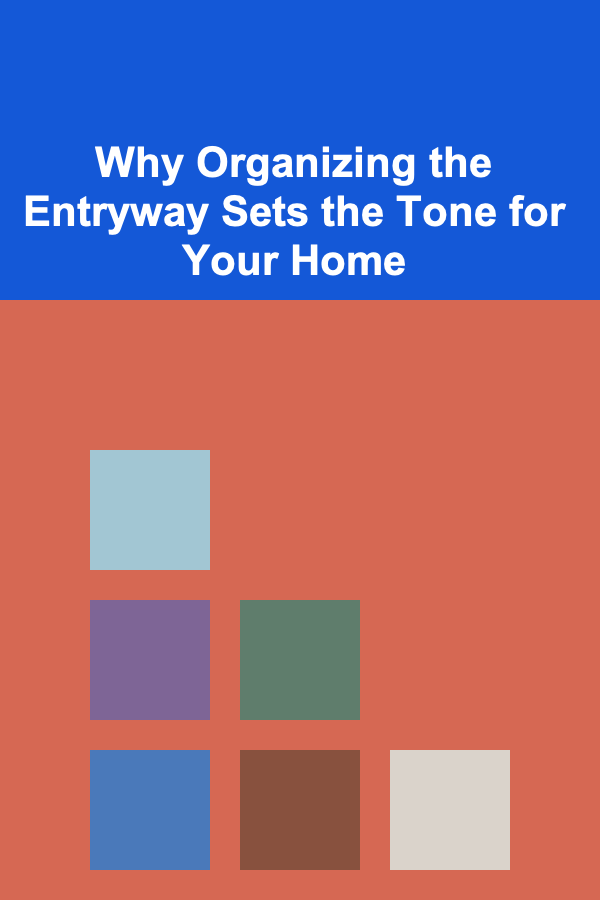
How to Present Your Industrial Design Ideas to Clients
ebook include PDF & Audio bundle (Micro Guide)
$12.99$10.99
Limited Time Offer! Order within the next:

Presenting industrial design ideas to clients is one of the most crucial parts of a designer's job. It's not just about showcasing your creative ideas and technical skills, but also about communicating the value of your designs in a way that resonates with the client's needs, brand, and goals. Successful presentations can result in not only winning the project but also in establishing long-lasting relationships with clients, which can lead to more opportunities down the line.
This article will delve into how to present your industrial design ideas effectively to clients, offering insights into preparation, communication, tools, and techniques that will help ensure your design concepts are not only understood but embraced.
Understand Your Client's Needs and Objectives
Before you even begin working on your design concepts, it's crucial to first understand the client's needs and business objectives. You should take the time to research their industry, brand identity, and target audience. A deep understanding of these elements will allow you to tailor your presentation to highlight aspects of your design that are most relevant to the client's goals.
Key Questions to Ask Your Client:
- What problem does the design need to solve?
- What are the functional requirements of the product?
- What materials, technologies, or production methods are preferred or necessary?
- How does the design align with the company's values and mission?
- What is the target market for the product?
- Are there any existing design preferences or constraints?
By gathering this information, you'll be able to present designs that not only meet the client's expectations but also go above and beyond to deliver a solution that is both creative and practical.
Develop a Clear Design Concept
Once you have a clear understanding of the client's needs, you can begin developing your design concepts. Keep in mind that industrial design is not just about aesthetics---it's about creating functional, user-friendly products that solve real-world problems. Your design should consider factors such as usability, ergonomics, manufacturability, and cost-effectiveness.
Key Components of a Strong Design Concept:
- Functionality: Ensure that the design is functional and addresses the primary need or problem outlined by the client.
- Aesthetics: While functionality is key, aesthetics also matter. The product should align with the client's brand identity and be visually appealing.
- User Experience (UX): Design with the end user in mind. Consider ergonomics, ease of use, and how the user will interact with the product.
- Sustainability: With increasing attention on environmental responsibility, showcasing sustainable design choices such as recyclable materials or energy efficiency can add significant value to your design.
- Innovation: If possible, introduce innovative elements that can differentiate the product in the market, whether through new technology, materials, or production techniques.
Once you have a clear concept, prepare several iterations and variations of your design to give the client options. Each version should have its own set of strengths, but all should meet the fundamental requirements.
Prepare for the Presentation
The way you present your design can be just as important as the design itself. A well-prepared presentation not only conveys your ideas effectively but also demonstrates your professionalism and dedication to the project.
Key Elements to Include in Your Presentation Preparation:
- Clear Visuals: Your design should be presented visually in the best possible way. High-quality renderings, sketches, prototypes, and animations will help the client visualize your ideas. Use visuals to emphasize the design's most important features.
- Technical Specifications: Along with the visuals, include detailed technical specifications such as dimensions, materials, and production processes. Ensure that the client can understand how the design will be manufactured and how it will perform in real-world conditions.
- Prototypes and Models: If possible, present physical models or prototypes of your design. This can help bring your concept to life and make it easier for the client to visualize the final product.
- Contextualization: Show how the product will fit into its intended environment. For example, you could present your design in the form of lifestyle images or even simulations of how the product will be used.
- Value Proposition: Be prepared to explain why your design is the best solution to the problem at hand. Highlight the value it will bring to the client's business, whether in terms of improving customer experience, reducing costs, increasing market share, or contributing to sustainability goals.
Focus on the Client's Perspective
While you may be excited about your design, the client's perspective is paramount during your presentation. Always frame your design solutions in a way that aligns with their goals, pain points, and business objectives.
How to Approach the Presentation from the Client's Point of View:
- Focus on Benefits, Not Just Features: Rather than simply describing your design's features, explain the benefits of those features in a way that connects directly with the client's objectives. For example, instead of just stating that a product is made from sustainable materials, explain how that contributes to the company's sustainability initiatives or reduces long-term costs.
- Highlight Cost-Efficiency: If your design offers potential cost savings, such as through the use of more affordable materials or simpler manufacturing processes, emphasize this. Clients are often concerned with the bottom line, and demonstrating how your design can save money or generate more profit can be a strong selling point.
- Show Impact on User Experience: Industrial design is not just about creating functional products---it's about improving the user experience. Demonstrate how your design enhances usability, increases comfort, and meets the needs of the end user.
Remember, your goal is to align your design with the client's vision, objectives, and goals, so they can clearly see how your concept will serve them.
Communicate Clearly and Confidently
Communication is key to presenting your industrial design ideas effectively. Be confident in your explanation, and ensure that you can clearly articulate the rationale behind each aspect of your design. Avoid jargon or overly technical language, unless you know that the client has the expertise to understand it.
Tips for Effective Communication:
- Be Clear and Concise: Stay focused on the main points. Avoid overloading the client with too much information at once. Summarize the key aspects of the design and the reasons behind your choices.
- Tell a Story: Instead of simply presenting your design, tell a story about how the design came to life. Explain how you arrived at this particular solution, the challenges you overcame, and how your design aligns with the client's needs.
- Engage the Client: Encourage questions and feedback during the presentation. This not only shows that you value the client's input, but it also helps foster a collaborative environment. Be open to critique and be prepared to explain your design decisions or make adjustments based on feedback.
- Be Prepared for Tough Questions: Clients may ask tough questions about your design, such as concerns about cost, durability, or scalability. Be ready to answer these questions thoughtfully and with evidence to back up your claims.
Use the Right Tools and Technology
Today's industrial designers have a vast array of tools and technology at their disposal to create and present their ideas. Leveraging the right tools can make your presentation more effective and help you communicate your design clearly.
Tools for Effective Design Presentation:
- 3D Rendering Software: Software like SolidWorks, Rhino, or AutoCAD can create high-quality renderings and models that allow the client to visualize your design in great detail.
- Animation: Adding animation to your presentation can bring the design to life. You can create animated walkthroughs or rotating views of your design to show how it functions in real life.
- Prototyping: Whether digital or physical, prototypes allow the client to interact with your design and get a hands-on feel for the product. 3D printing is a popular option for quickly creating prototypes.
- VR or AR: Virtual Reality (VR) or Augmented Reality (AR) technology allows clients to experience your design in a fully immersive environment. This is particularly useful for larger-scale products or interactive designs.
Follow Up After the Presentation
Once the presentation is complete, don't forget to follow up with your client. Send them a summary of the key points discussed, including the design features, benefits, and next steps. Make yourself available for any further questions and be prepared to adjust your design based on client feedback.
Tips for a Successful Follow-Up:
- Send a Thank You Note: Always thank your client for their time and consideration. A personalized note can go a long way in building a good relationship.
- Provide Additional Information: If the client requested more details about specific aspects of your design, provide this information promptly.
- Stay Flexible: Be prepared for revisions based on client feedback. Be open to making adjustments and refining your design.
Conclusion
Presenting industrial design ideas to clients is an essential skill for any designer. A successful presentation goes beyond just showcasing your creativity---it involves clear communication, strategic thinking, and a deep understanding of the client's goals. By following the steps outlined above, you can present your industrial design ideas in a way that resonates with your client, strengthens your professional reputation, and increases the likelihood of a successful outcome. Ultimately, the goal is to foster a collaborative, positive relationship with your client, ensuring that your design not only meets their needs but also exceeds their expectations.
Reading More From Our Other Websites
- [Organization Tip 101] How to Curate a Collection of Dining Room Art
- [Personal Care Tips 101] How to Use Hair Serum to Detangle Hair Easily
- [Polymer Clay Modeling Tip 101] Mastering the Basics: Essential Polymer Clay Techniques for Beginners
- [Weaving Tip 101] Sustainable Style: Using Recycled Fibers in Hand-Weaved Home Décor
- [Tie-Dyeing Tip 101] How to Achieve Perfect Spiral Tie‑Dye Effects on Denim Jackets
- [Personal Care Tips 101] How to Apply Conditioner for Maximum Hair Softness
- [Organization Tip 101] How to Use Furniture Arrangements to Maximize Space
- [Weaving Tip 101] Step-by-Step Guide to Building Your First Handloom for Yarn Weaving
- [Tiny Home Living Tip 101] How to Navigate Zoning Laws and Permits for Tiny Home Communities
- [Screen Printing Tip 101] Top Must-Have Tools in a Beginner Screen Printing Kit (And Where to Find Them)

How to Achieve an Eco-Friendly Home with Sustainable Lighting Solutions
Read More
How to Create a Checklist for Website User Feedback Collection
Read More
How to Create a Cozy and Organized Home Office
Read More
Why Organizing the Entryway Sets the Tone for Your Home
Read More
How To Photograph the Aurora with Long Exposure
Read More
10 Tips for Etching Glass Without a Professional Etching Cream
Read MoreOther Products

How to Achieve an Eco-Friendly Home with Sustainable Lighting Solutions
Read More
How to Create a Checklist for Website User Feedback Collection
Read More
How to Create a Cozy and Organized Home Office
Read More
Why Organizing the Entryway Sets the Tone for Your Home
Read More
How To Photograph the Aurora with Long Exposure
Read More